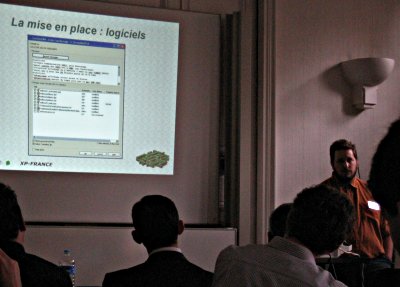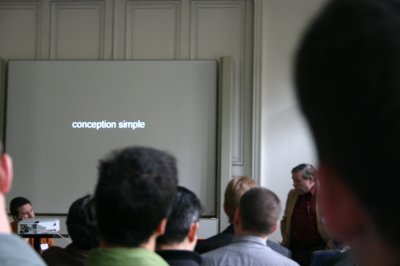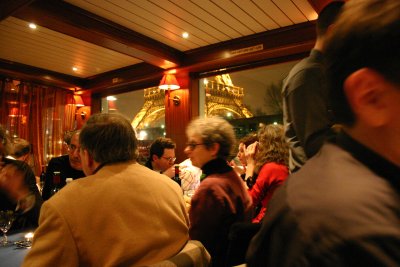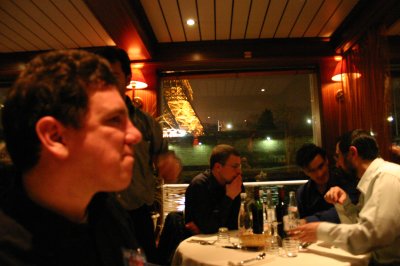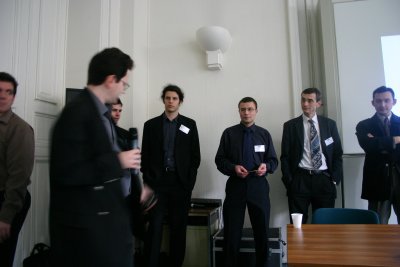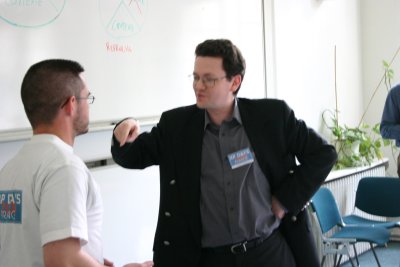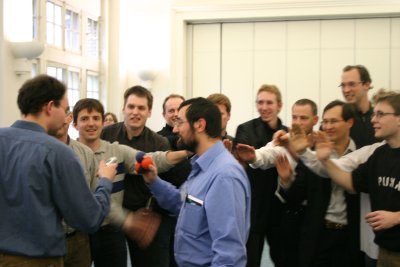As you can see from my other entries, I was at AYE last week. I’ll try to summarize a number of sessions here. The sessions, are as usual, only part of what makes the conference. As Jerry Weinberg pointed out in both the opening and closing session, the most important people at the conference are not the organisers, but ‘the person to the left of you, and the person to the right of you’. I disagree sort of, since the organisers are also ‘to the left and right of me’  . A conference means to me always a 16 hour work day – 8 hours of sessions followed by 8 hours of dinners, lunches and drinks, and there was no shortage of interesting persons here.
. A conference means to me always a 16 hour work day – 8 hours of sessions followed by 8 hours of dinners, lunches and drinks, and there was no shortage of interesting persons here.
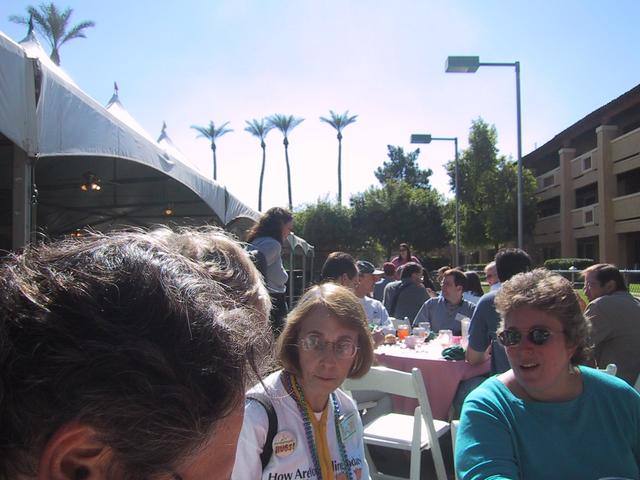
Lunch with palmtrees at AYE, in the foreground Naomi Karten and Johanna Rothman
In a previous entry I already went into Jean Mc Lendon’s great session on Satir Systems Coaching, so I won’t repeat that here. The sessions below are the ones that stand out in my memory at the moment.
Interviewing with Ease
This workshop facilitated by Joanna Rothman was interesting and practical. To the left and right of me were managers hiring people, as well as persons on the ‘other side’ of the job interview process, looking for work.
Most hiring managers in the group were having problems with large amounts of applications for each open position. One has to strike a balance between the amount of time spent interviewing people, and the chance of a ‘bad hire’. Hiring someone you later have to fire is very expensive, in terms of both costs and morale in your teams. Having an HR department do screening before you as a manager with more technical and functional knowledge before you can seem efficient, but they can easily put off the best candidates, or fail to see through tricks by not-so-good candidates.
Johanna recommended coducting so called phone screens, with the most important dissatisfiers early in the phone screen. A phone screen is a scripted telephone interview (in the same vein that is used for telemarketing). An example of a dissatisfiers is e.g. ‘are you willing to travel 25% of your time’ – if that is required for the the job and the applicant says no, you can end the phone screen right away (don’t forget to thank the applicant for their time of course). In 5 to 15 minutes you can quickly decide which persons you want to invite for an interview.
We spent some time thinking about (il)legal questions. Surprising to me, the USA is quite highly regulated with respect to questions you can not ask. Whenever I met someone, they would often ask ‘where are you from’, and ‘where are you based’. In a job interview it is illegal to ask about the applicants place of birth apparently, whereas this is a default component of a Curriculum Vitae in The Netherlands. Questions about fluency in certain languages are only permitted if they are essential for the job.
The group then did an exercise on Behavior description questions, these are a special kind of open question, asking the applicant to describe what he or she did in a specific situation in a past project. One can use these questions to find out relevant behaviour to the job in question, without spending too much time explaining about your current situation – job interviews are typically way too short to give both the company and the applicant sufficient time to go deeply into each-others’ situation. An example of such a question would be “What did you do last time you disagreed with a team-mate? With a Manager?” or “What did you do when a customer was dissatisfied?”.
An interesting trick that came up, is the so called “dirtbag test”, to sift out the real assholes from the population…. If you want people in your organisation to respect each other, have a junior assistant call the applicants to verify something on the CV – if the candidate is not respectful towards the assistant, dismiss the application.
Panel interviews may seem efficient ways to conduct interviews, but they are in fact the opposite. See for an amusing story and more details Johanna’s blog entries When Candidates Run Interviews and Panel Interviews.
After the workshop I decided to pre-order some copies of Johanna’s forthcoming book Hiring Technical People, which looks promising, and useful to me when we decide to expand cq2′s software studio beyond our current network.
Firing technical people
or, Managing team membership, who’s in and who’s out by Becky Winant and Steve Smith. Follow the link to see photos by Steve Smith.
The workshop revolved around an exercise having two teams of participants (‘team 1′ and ‘team A’) stand on a flipover. With each round, the amount of available paper to stand on halved, leading to acrobatic situations like this: 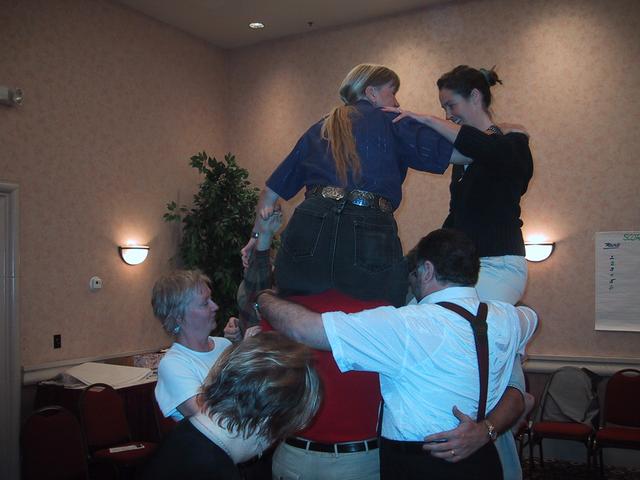
“Sue and Deirdre on the shoulders of Vadim and others, Esther watching, Becky checking if all feet are completely on the paper.”
The image above is of Team 1, my Team A was much less acrobatic, since we decided (it took me some effort to convince the others to do this  ) to tear apart the flipover and stand on separate pieces early on. Eventually, it got to the point where there was of course not enough paper for everyone to stand on. So I was the first to check out (“I came here to stand relaxed on a piece of paper, not do acrobatics – I need a beer”) and go to the IFEP (Institute For Excluded People) where a bunch of Team 1 members had already gathered.
) to tear apart the flipover and stand on separate pieces early on. Eventually, it got to the point where there was of course not enough paper for everyone to stand on. So I was the first to check out (“I came here to stand relaxed on a piece of paper, not do acrobatics – I need a beer”) and go to the IFEP (Institute For Excluded People) where a bunch of Team 1 members had already gathered.

“I need a beer” – image courtesy of Steve Smith
After we stopped laughing from the game, we shared team exclusion and firing stories. Some of the suggestions that stuck in my mind:
- Have regular person-to person meetings with those who work for you. Don’t do performance reviews once a year only.
- Don’t delay difficult decisions (one participant reported productivity of his team tripled after he fired a disfunctional team-member) – after you make the decision, it is likely that everyone will be relieved, even the ones you let go.
- Give advance warning, be specific in your performance targets & reviews.
- If you want to be an effective manager, don’t be afraid of firing someone – it is part of your job.
Collaborative decision making
I went to this session by Jim Highsmith, because I’m interested in how one can quikly make fairly good decisions with a group, without falling back to an authoritararion style. Jim drew the following continuum, indicating his preference for the “self organizing” style in the middle:
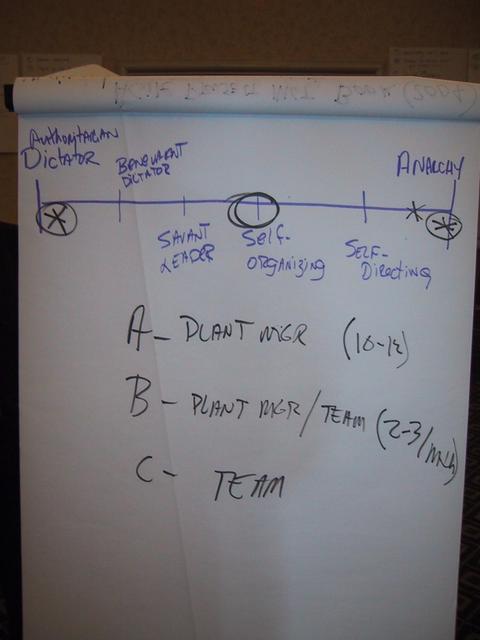
I rembember most the three phase model for discussion, liberally translated in my mind as ‘diverge, argue, converge’. To come to a decision in the converge phase, one can take a vote, using a continuum from ‘veto’ ‘object but would not veto’, ‘?’, ‘agree with reservations’ to ‘fully agree’.
Jim illustrated the importance of divergence with an example from Toyota, where they keep their options for a new car open as long as possible – until a car finally goes into production, they will develop more than one drivetrains, transmission, chassis and engine. This helps them solve problems with production – because not everything designed can be easily produced. If there is a problem with manufacturing, they can choose to one of the other options.
The diverge phase is akin to brainstorming, because we don’t want to dismiss too many options.
I am looking forward to reading Jim’s literature suggestion, “A facilitator’s guide to participatory decision making” by Sam Kaner, as well as the book Jim is currently working on, “Agile Project Management”.
Enhancing Your Personal Influence: From Novice to Maestro
See the session notes for some observations of others on this session facilitated by Becky Winant and Jerry Weinberg. This session revolved around an exercise where a client had to get the best advice possible from a consultant, and the consultant had to give the best advice possible.
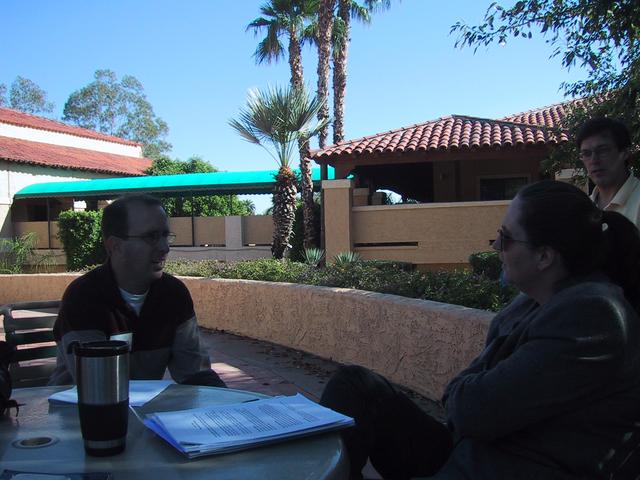
a client (left) and a consultant
The client and consultant were given instructions to this effect before the interview. Contrary to what is usual in this kind of game, the client and consultant were not given adversarial instructions. This didn’t help the client I was observing in the above picture… The client kept asking ‘are you the best consultant for this’, and asked a question about price in the first 2 minutes – this helped setting an adversarial athmosphere… In a sense this meeting between client and consultant was a success, because they quickly discovered they were not a good match.
The next round turned out to be quite hilarious. Since I’m really starting to like roleplaying, I played consultant. In this round, the instructions were a bit different: the consultant had to give the best advice possible and get a fee for his work. When the client arrived, it turned out he wanted a travel consultant, to plan a trip to Maine. I quickly transformed myself into a travel agent, even though I did not know where Maine was  . Luckily the client told me he wanted to go there by bus, so I didn’t have to suggest it… I also didn’t know anything about available hotels and prices, so I stalled the client, asking him for a price bracket and promising to get back to him the following day…
. Luckily the client told me he wanted to go there by bus, so I didn’t have to suggest it… I also didn’t know anything about available hotels and prices, so I stalled the client, asking him for a price bracket and promising to get back to him the following day…
It turned out both client and consultant had screwed each other a bit… The consultant got a price bracket below what the client had spent last year, and the client was working with a clueless travel consultant! Both client and consultant had a fairly good feeling after the meeting
So, I learnt that I’ve become quite proficient at sales meetings, although venturing too far out in the unkwown can be risky. The observers told me I had been making good eye-contact (which i’ve been working on in the past year). Next time, I’ll ask even more questions.
Closing session
This one was totally hilarious. Naomi Karten asked all particpants to split up in clumps of three, and make a trip-report in fake powerpoint presentation style. Did I mention none of the other sessions at AYE used slides? I’ll let the pictures do the talking:
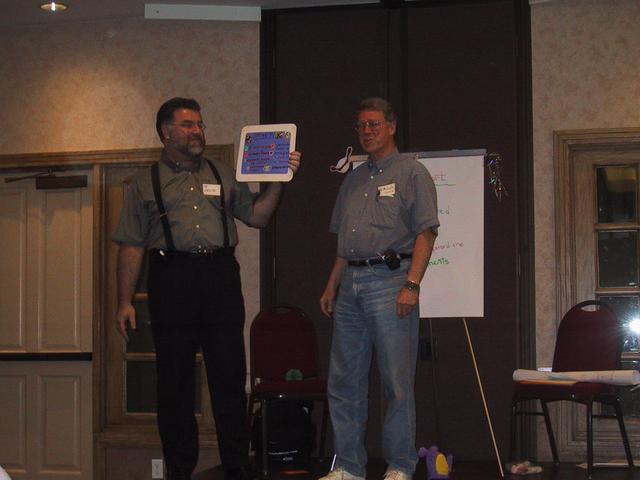
Vadim Temkin and Malcolm Curry doing their trip report in Russian – hilarious
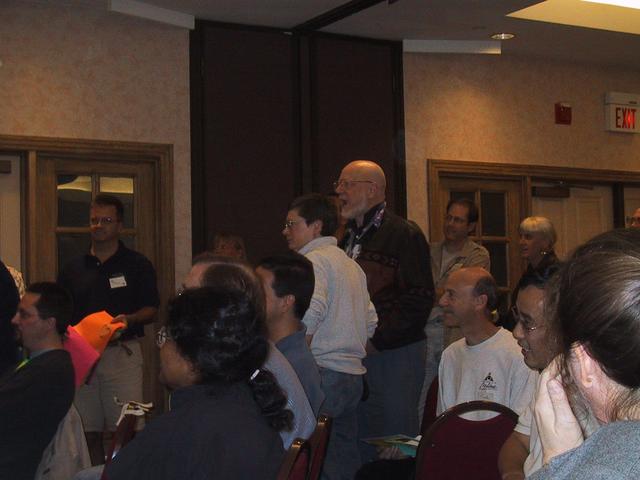
Participants actively involved, as in the other sessions at AYE
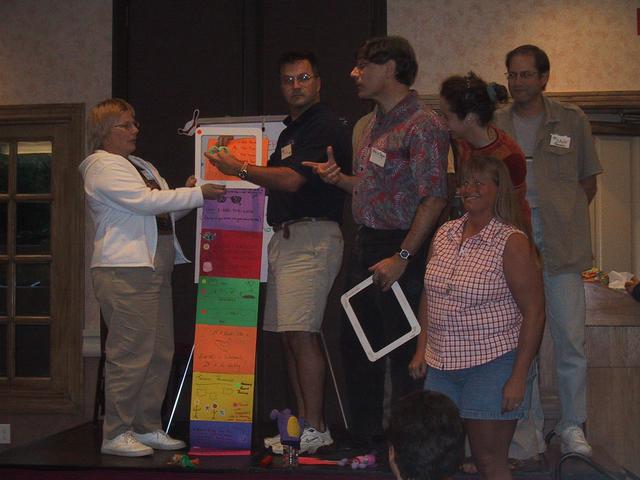
Paul was having “blue screens of death” in orange and yellow

“And now for something completely different”, Phil and Jay had a bi-lingual presentation in cockney and new-yorks. I can’t remember what the slide with the chicken was about 
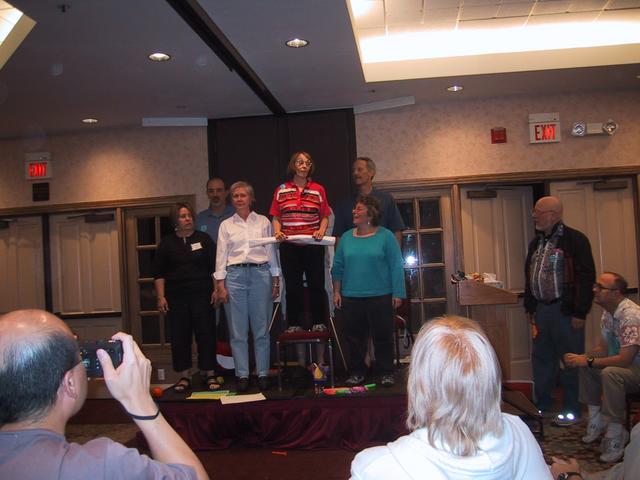
And finally, after Naomi appreciated the participants for several things, it is time to appreciate the organizers. From left to right: Becky Winant, Don Gray, Esther Derby, Naomi Karten, Johanna Rothman, Steve Smith, and on the far right: Jerry Weinberg. Thank you for a wonderful time at AYE!










